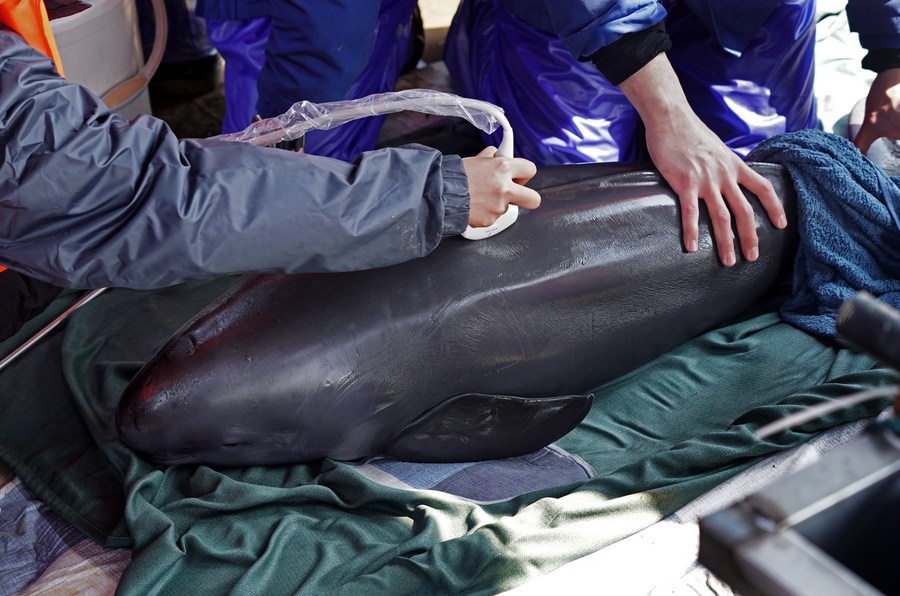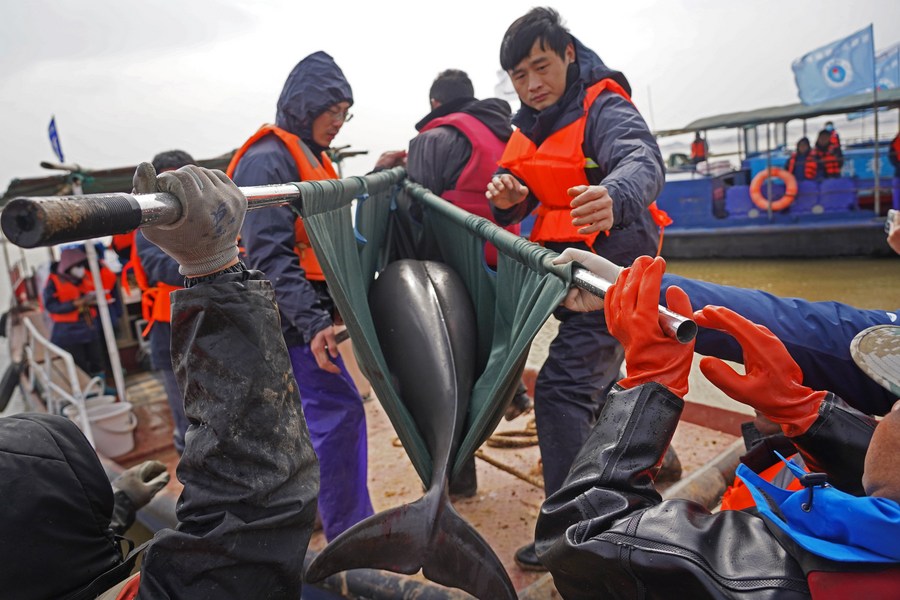
Newsroom
Finless Porpoises in Poyang Lake Relocated for Better Protection

Researchers conduct physical examination for a finless porpoise in Songmenshan area of Poyang Lake in east China's Jiangxi Province, Feb. 15, 2023.(Xinhua/Wan Xiang)
NANCHANG, Feb. 21 (Xinhua) -- Two Yangtze finless porpoises in Poyang Lake, China's largest freshwater lake, were successfully relocated for better protection.
Due to drought in the middle and lower reaches of the Yangtze River in 2022, over 30 finless porpoises in the Songmenshan area of the Poyang Lake in Duchang County, Jiangxi Province, failed to swim back to the deep water area.
To reduce potential risks such as stranding and food shortage, the Department of Agriculture and Rural Affairs of Jiangxi Province and the Institute of Hydrobiology under the Chinese Academy of Sciences carried out a Yangtze finless porpoise relocation operation in Poyang Lake.
The finless porpoise is iconic in the Yangtze River, the country's longest river. It's under top-level state protection in China. The species, known as the "giant panda of the water," is a barometer of the ecological environment in the Yangtze River basin. Poyang Lake is also an important habitat for these mammals.
Before the relocation, these finless porpoises were caught and transferred to a boat for physical examination.
Finless porpoises usually reach adulthood at the age of five or six, and the expert team tried to choose young and middle-aged individuals. Those not suitable for moving out would go back into the lake directly, said Liu Kai, a researcher at the Freshwater Fisheries Research Center of the Chinese Academy of Fishery Sciences.
The environment of the waters in the south of the Songmenshan area of Poyang Lake is good, and the pregnancy rate of finless porpoises there is high. A total of 21 finless porpoises were caught during this mission, 15 males and six females. Five of the female finless porpoises are pregnant, and the other is a one-year-old juvenile porpoise, all of which were put back into the lake.
The expert team used ultrasonic instruments to check the condition of their organs, carry out shape measurements, mark scanning, and collect biological samples.

Staff members carry a finless porpoise to conduct physical examination in Songmenshan area of Poyang Lake in east China's Jiangxi Province, Feb. 14, 2023. (Xinhua/Wan Xiang)
After three days of artificial rounding-up, physical examination screening, and transportation, two male finless porpoises were selected and successfully relocated to the waters of Poyang Lake in Hukou County.
It takes about an hour to drive from Duchang County to Hukou County. The staff carefully put the finless porpoises into the transport boxes, straightened their positions, and covered their backs with moist towels to keep their body surface wet.
Dai Yingen, a researcher at Jiangxi aquatic biological protection and rescue center, said to help finless porpoises arrive at their new residence safely, they not only used specially designed transport boxes but also prepared emergency medicine to prevent finless porpoises from stress reactions during transportation.
The two finless porpoises were finally transported to the temporary breeding base in the waters of Hukou County. The staff carefully moved the finless porpoises to the boats with stretchers. When reaching the deep water area, they put them into the water.
Last year, affected by drought in the middle and lower reaches of the Yangtze River, the lowest water level in Poyang Lake fell below the historical value.
The Jiangxi Provincial Department of Agriculture and Rural Affairs organized six emergency operations and successfully relocated 111 trapped finless porpoises to the deep water area.
According to the plan, eight finless porpoises will be selected from Poyang Lake in this conservation operation and transported and released to reserves in Anhui Province, Hubei Province, and Hukou County of Jiangxi.
Liu Kai said that the relocation of finless porpoises is mainly to promote the optimization of the existing finless porpoise population structure in the Yangtze River Basin, enrich genetic diversity, and support the sound development of the Yangtze finless porpoise population.